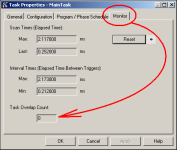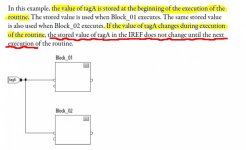stallone
Member
Hi guys,
i have a problem with one of my customers packing line, we use
encoder pulses to calculate a size of the packaging reel diameter and we have had incosistent pulses. We have also scoped the encoder pulses and confirmed that they are of perfect shape, and remain consistent.
We did suspect that, being that the required encoder supply voltage is only 12Vdc, and hence, the resultant encoder pulses are only 10Vdc, the pulses would be too small to switch the 24Vdc digital input module that the pulses are being fed to, consistently. Hence, for test, we introduced a simple pulse amplifier circuit that, once connected, amplified the pulses to a more favourable 20Vdc, but that provided no improvement.
We now suspect that, since the pulses are being fed to a standard 24Vdc, digital input module, a 1756-IB32, that perhaps the frequency of the incoming pulses at 104Hz, is too much for that standard module to handle perhaps?
There are 2 high speed counter modules in the rack, 1756-HSCs.
maybe i am best off using one of those to count the pulses.
i have a problem with one of my customers packing line, we use
encoder pulses to calculate a size of the packaging reel diameter and we have had incosistent pulses. We have also scoped the encoder pulses and confirmed that they are of perfect shape, and remain consistent.
We did suspect that, being that the required encoder supply voltage is only 12Vdc, and hence, the resultant encoder pulses are only 10Vdc, the pulses would be too small to switch the 24Vdc digital input module that the pulses are being fed to, consistently. Hence, for test, we introduced a simple pulse amplifier circuit that, once connected, amplified the pulses to a more favourable 20Vdc, but that provided no improvement.
We now suspect that, since the pulses are being fed to a standard 24Vdc, digital input module, a 1756-IB32, that perhaps the frequency of the incoming pulses at 104Hz, is too much for that standard module to handle perhaps?
There are 2 high speed counter modules in the rack, 1756-HSCs.
maybe i am best off using one of those to count the pulses.







